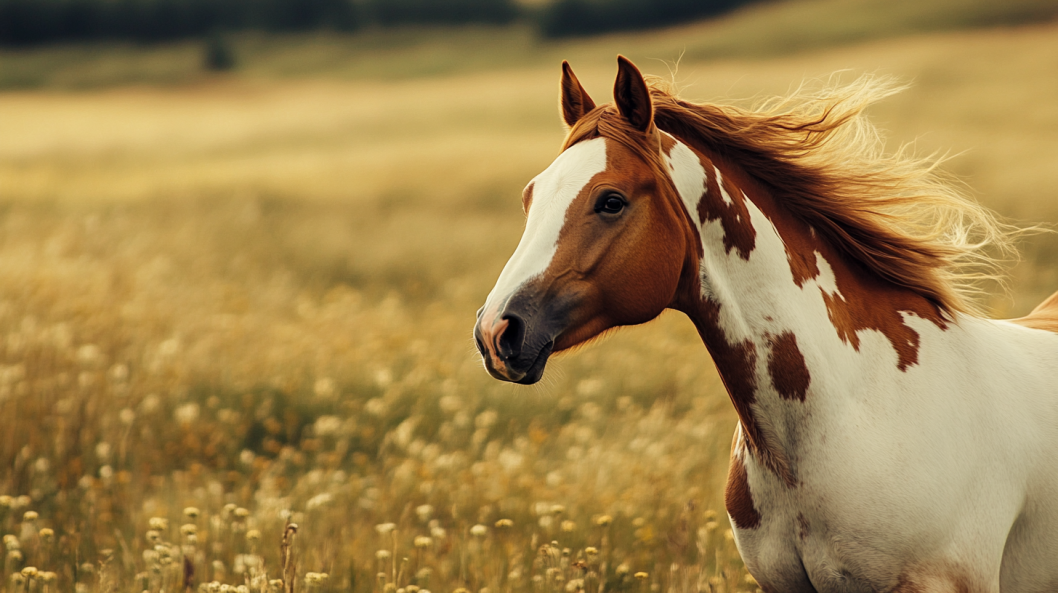The Pinto horse, with its striking coat patterns and captivating appearance, has been a favorite among equestrians and horse enthusiasts for centuries. Known for its unique blend of colors and the intriguing history behind its development, the Pinto belongs to the lineage of historic horses that have played significant roles throughout history, making it much more than just a pretty face.
Growing up, I enjoyed watching old Western movies with my family, mesmerized by the beautiful horses galloping across the screen. One horse in particular always caught my attention – the Pinto horse. Its striking coat, a patchwork of white and rich colors, made it stand out from all the others. I didn’t know much about horses then, but the Pinto’s distinctive appearance impressed me. Over the years, my fascination with Pinto horses grew, and I discovered that their rich history and cultural significance matched their beauty.
Let’s delve into the origins and historical journey of this remarkable breed.
Origins and Early History
The term “Pinto” refers not to a specific breed but to a type of horse distinguished by its colorful coat patterns. The word itself is derived from the Spanish word “pinto,” meaning “painted” or “spotted.” Pinto horses are characterized by their distinctive coat patterns, which can include a variety of color combinations such as overo, tobiano, and tovero.
Spotted or Pinto horses first arrived in the New World with the Spanish conquistadores. From that day forward, animals of this color played a leading role in the development of the West. Many of them were captured and used as the highly prized riding horses of the American Indians. Later, they were found among the feral horses of the West, and, most importantly, many of them have been used as stock horses through the years.
Development and Popularity
During the 19th century, Pinto horses gained popularity in North America. They were particularly favored by Native American tribes, who valued their striking appearance and unique patterns. These horses often appeared in tribal ceremonies and were an important part of Native American culture.
The breed’s popularity continued to grow, leading to the formation of organizations dedicated to the Pinto horse. In 1956, the Pinto Horse Association of America (PHAA) was established, significantly promoting and preserving the breed. This organization and others that followed worked to standardize Pinto horse traits and ensure the breed’s continued recognition.
Pinto Characteristics
Pinto horses are celebrated for their vibrant coat patterns, which result from genetic factors rather than breed-specific traits. These patterns can vary widely, but they all share a common thread of beauty and uniqueness. The most common patterns include:
Tovero: A combination of the tobiano and overo patterns, with distinctive markings that might include a mix of both patterns.
Tobiano: Marked by white spots that cross the back, with the legs and lower parts of the body often covered in white.
Overo: Featuring irregular white patches that do not cross the back, often with a distinct pattern around the belly and sides.
Modern-Day Pinto Horses
Today, Pinto horses are known for their versatility and are used in various disciplines, including dressage, jumping, and western riding. Their vibrant appearance and gentle temperament make them popular among riders of all skill levels.
The Pinto Horse Association of America and other similar organizations continue to play a crucial role in the breed’s development, hosting events and shows that highlight the Pinto’s unique beauty and abilities. These organizations also work to educate the public about the breed’s history and importance, ensuring that the Pinto horse remains a beloved part of the equestrian world.
Adaptation and Use
Colonel F. W. Koester has summarized the adaptation and use of the Pinto horse well in the following statement: There is the Pinto pony—long the pride and joy of millions of American youth. We find Pintos, too, among the cow ponies and polo ponies, jumpers, hunters, and other sporting types. Again, the Pinto enjoys wide and deserved popularity among the pleasure types such as trail horses, hacks, and particularly parade horses.” In brief, the Pinto is adapted for any light-horse purpose, but it is especially superb as a show, parade, novice, and pleasure animal.
The Pinto horse, with its rich history and stunning appearance, is more than just a colorful equine companion. Its origins, tied to early explorers and Native American culture, contribute to a legacy that has evolved over centuries. Whether you’re an equestrian enthusiast or simply an admirer of beautiful horses, the Pinto’s history and distinctive patterns offer a fascinating glimpse into equine diversity.





